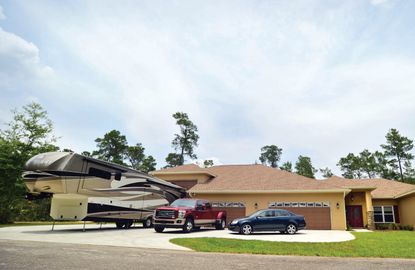Find Your Niche in a Retirement Enclave
Whether you have an interest in the arts or RVs, you can find a retirement community that caters to like-minded people.


In our friendships, we often gravitate toward people who share our values, interests and lifestyles. Now many older adults are taking this kind of social networking to a new level. They are moving to affinity, or niche, communities that cater to like-minded people.
The intellectually curious are moving to retirement communities near or on college campuses, for example. Older immigrants are finding enclaves where residents share their cultural backgrounds. And three retirement colonies in Southern California cater to retired artists, writers, actors, directors, producers and those who love the arts in general. "We no longer want to settle for cookie-cutter housing," says Dan Owens, executive director of the National Active Retirement Association, which advises governments and businesses. "Niche communities are going to be a huge market."
Down the road, there could be enclaves for, say, avid gardeners or music lovers. Chris Whitson, a developer from New Mexico, hopes to launch CruiseLT (as in long-term care) in 2016. He plans to build three cruise ships for those age 65 or older with nursing care and dialysis for those who need it, but also staterooms for the healthy and hearty who love to travel. We've explored four types of niche housing available today.

Sign up for Kiplinger’s Free E-Newsletters
Profit and prosper with the best of expert advice on investing, taxes, retirement, personal finance and more - straight to your e-mail.
Profit and prosper with the best of expert advice - straight to your e-mail.
A lifestyle with class. University-based retirement communities (UBRCs) give the expression "senior on campus" a new meaning. Located on or near a college campus, the 60 or so UBRCs tend to be continuing-care retirement communities, offering the spectrum of care, from independent living to assisted living to skilled nursing. Entrance fees are typically $100,000 to $500,000, along with monthly fees of $2,500 to $5,000 for meals and other amenities.
In 2011, Donna Baznik, age 69, and her husband, Dick, 72, moved to Kendal at Oberlin, a retirement community with a full range of medical care (Dick has health issues), one mile from Oberlin College in Oberlin, Ohio. They loved the idea of "living in a great and stimulating small college town," Donna says.
The couple moved to Kendal from Cleveland, 35 miles away, where Dick was a Case Western Reserve University administrator and Donna taught at an early childhood program. Donna has taken courses at Kendal on topics as diverse as China, sign language and opera.
The Bazniks can use the Oberlin facilities and audit courses at no charge. They're regulars at lectures and programs. Oberlin's Conservatory of Music has more than 400 concerts and recitals a year on campus. Its students sometimes rehearse at Kendal. "There is never a want of things to do here," says Donna.
Kendal Corp. runs many university-based retirement communities, including one in Ithaca, N.Y., near Ithaca College and Cornell University, and another in Lexington, Va., near Washington and Lee University and Virginia Military Institute. Before signing on to a UBRC, make sure you understand the connection between the college and the retirement community.
LGBT living. Older lesbian, gay, bisexual and transgendered (LGBT) adults sometimes face an icy reception at traditional retirement communities. That makes the few LGBT communities especially appealing.
Eight years ago, Lissa Brown, 71, and her partner, MaryAnn Urka, 62, moved from Takoma Park, Md., to Carefree Cove (www.carefreecove.com), an LGBT enclave in Zionville, N.C. "We can be ourselves," says Brown. "You use up energy trying to conceal who you are or avoid being around people who won't be accepting. We don't have to deal with those things here."
The couple spent $60,000 for their lot and built a four-bedroom log cabin in the mid $300,000s. Everything is on one floor so they can age in place. "I plan to die here," says Brown. Her neighbors -- couples and singles, men and women, mostly in their fifties and sixties -- have moved to the Appalachian Mountains from New York, Connecticut and Florida, among other states. All but 16 lots out of 86 have been sold.
An hour north of San Francisco in Santa Rosa, Cal., is a swanky LGBT community for those 55 and older that opened in November 2013, called Fountaingrove Lodge (www.fountaingrovelodge.com). Ten percent of the residents are heterosexual.
Entrance fees for the 10-acre campus run from $189,500 to $925,500, and monthly fees are $3,395 to $6,125. If you leave or die, the entire entrance fee is refundable once the unit is resold.
John Kennedy, 71, a former educator, and his spouse, Bill Baird, 67, who worked in information technology, moved in last December. "I keep thinking I'm living at a resort where everything gets done for me," says Kennedy. "It is such a beautiful place."
[page break]
The dining room, with three walls of glass overlooking the Sonoma Valley hills, serves three-course gourmet meals nightly. Kennedy says if he or Baird gets sick, they can get assisted living, memory care or hospice in the privacy of their independent living unit.
The same culture. Older immigrants might have lived with their children in their home country, but it is often different in the U.S. So some are seeking the comfort of niche communities.
Aegis Gardens (www.aegisliving.com/aegis-living-of-aegis-gardens), in Fremont, Cal., offers assisted living and memory care for Chinese immigrants. The staff speaks various dialects of Chinese, and residents can take tai chi and calligraphy or play mahjong. The architecture and interiors are designed using feng shui.
In Tavares, Fla., near Orlando, is ShantiNiketan (www.shantiniketan-us.com) for immigrants from India; ShantiNiketan means "a place of peace" in Hindi. Trishla and Rana Gupta moved to one of ShantiNiketan's 54 condos two years ago from Michigan. It is three hours from one son and his family; another son and his family are in Michigan.
The Guptas do yoga several days a week and, if they want, can meditate in the prayer room, complete with Hindu statues. "It's the only community of its kind where we can get the food we like," says Rana, 76, a retired engineer who came to the U.S. in 1969. Condos run from $200,000 to $250,000. "People here speak different Indian languages, but we have a common culture and everyone knows Hindi and English. It's diversified and intellectually stimulating," says Rana.
Another 600 condos are on the drawing board in Ocklawaha, Fla., while ShantiNiketan projects in Detroit, Los Angeles, Phoenix and Princeton, N.J., also are in various stages of development.
Big garages for big toys. At Lake Weir Preserve (www.lakeweirliving.com), in Ocklawaha, Fla., the garages (2,000 to 3,000 square feet) are often bigger than the homes. Those who choose this retirement community want a place to store their car collections, recreational vehicles or boats, or have spacious workshops or art studios. Co-developer Neil Schuster calls the garages "custom dream rooms to keep big toys."
One resident has 16-foot ceilings and a car lift so he can restore cars. Another collects cars in mint condition and has room in his garage for 10 vehicles.
Jay Bird and his wife, Denise, both 58 and from the Maryland suburbs of Washington, D.C., had Schuster build three garages, one large enough for their RV. Jay also requested a "man cave" in the back of the big garage, with air conditioning, heating and a bathroom, for when the Birds aren't on the road in their RV.
Jay, a retired Pentagon worker, and Denise, a former kindergarten teacher, also like the price tag: less than $500,000 for a 2,600-square-foot house, 2,400-square-foot-garage and in-ground pool. Chalk it up to its location in central Florida. "If the Birds had built their home outside D.C., it would cost $1.3 million, and if it were in South Florida or Naples, it would cost several million dollars," says Schuster.
The developer has found a unique niche. So far, he has built 25 houses near the Birds', and within five years, expects to complete 100 more.

-
 Starbucks BOGO and New Sweet and Spicy Drinks
Starbucks BOGO and New Sweet and Spicy DrinksFor a limited time, Starbucks is announcing four new "swicy" drinks that are both spicy and sweet.
By Kathryn Pomroy Published
-
 Stock Market Today: Dow Slips After Travelers' Earnings Miss
Stock Market Today: Dow Slips After Travelers' Earnings MissThe property and casualty insurer posted a bottom-line miss as catastrophe losses spiked.
By Karee Venema Published
-
 403(b) Contribution Limits for 2024
403(b) Contribution Limits for 2024retirement plans Teachers and nonprofit workers can contribute more to a 403(b) retirement plan in 2024 than they could in 2023.
By Jackie Stewart Published
-
 SEP IRA Contribution Limits for 2024
SEP IRA Contribution Limits for 2024SEP IRA A good option for small business owners, SEP IRAs allow individual annual contributions of as much as $69,000 a year.
By Jackie Stewart Published
-
 Roth IRA Contribution Limits for 2024
Roth IRA Contribution Limits for 2024Roth IRAs Roth IRA contribution limits have gone up for 2024. Here's what you need to know.
By Jackie Stewart Published
-
 SIMPLE IRA Contribution Limits for 2024
SIMPLE IRA Contribution Limits for 2024simple IRA The maximum amount workers at small businesses can contribute to a SIMPLE IRA increased by $500 for 2024.
By Jackie Stewart Published
-
 457 Contribution Limits for 2024
457 Contribution Limits for 2024retirement plans State and local government workers can contribute more to their 457 plans in 2024 than in 2023.
By Jackie Stewart Published
-
 Roth 401(k) Contribution Limits for 2024
Roth 401(k) Contribution Limits for 2024retirement plans The Roth 401(k) contribution limit for 2024 is increasing, and workers who are 50 and older can save even more.
By Jackie Stewart Published
-
 7 Things Medicare Doesn’t Cover
7 Things Medicare Doesn’t CoverHealthy Living on a Budget Medicare Part A and Part B leave some pretty significant gaps in your health-care coverage. But Medicare Advantage has problems, too.
By Donna LeValley Last updated
-
 Is a Medicare Advantage Plan Right for You?
Is a Medicare Advantage Plan Right for You?Medicare Advantage plans can provide additional benefits beneficiaries can't get through original Medicare for no or a low monthly premium. But there are downsides to this insurance too.
By Jackie Stewart Published